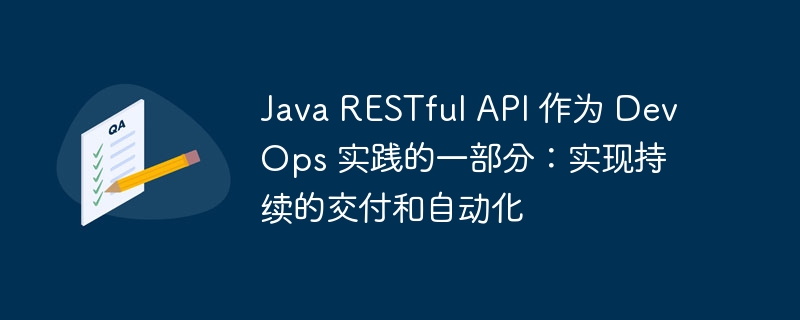Home >Java >javaTutorial >Java RESTful API as part of DevOps practices: enabling continuous delivery and automation
Java RESTful API as part of DevOps practices: enabling continuous delivery and automation
- 王林forward
- 2024-03-09 09:01:05906browse

Java RESTful API, as part of DevOps practices, plays a crucial role in enabling continuous delivery and automation. In the modern software development process, using RESTful APIs can help teams collaborate better, improve development efficiency, and achieve rapid deployment. This article will explore how to use Java to write RESTful APIs and combine it with DevOps concepts to achieve best practices for continuous delivery and automation. Help developers better understand and apply this important technology through technical discussions and actual case analysis.
Java RESTful api offer a variety of advantages that make them valuable tools in devops practice:
- Loose coupling: RESTful API follows a loosely coupled architecture, allowing different services to be easily integrated.
- Portability: RESTful API based on the Http protocol can be used on a variety of platforms and environments.
- Scalability: RESTful APIs can be easily scaled to handle growing load and functionality.
Integrating Java RESTful API into DevOps process
To integrate the Java RESTful API into your DevOps process, you need to perform the following steps:
- Define the API specification: Define the API specification using a tool such as swagger or OpenAPI to describe the API's endpoints, data model, and operations.
- Implement the API: Implement the API using a Java framework such as Spring Boot, Jakarta RESTEasy or Jersey, and follow the specification.
- Automated testing: Unit and integration testing of APIs using frameworks such as JUnit, Mockito and REST Assured.
- Continuous Integration: Integrate API code into a continuous integration pipeline to automatically build, test, and deploy code after every commit.
- Continuous Delivery: Deploy updated APIs to production through a continuous delivery pipeline to achieve frequent and reliable delivery.
Demo code:
The following demo code snippet shows a simple Java RESTful API using the spring Boot and Swagger specifications:
import org.springframework.boot.SpringApplication;
import org.springframework.boot.autoconfigure.SpringBootApplication;
import org.springframework.WEB.bind.annotation.*;
@SpringBootApplication
public class ApiApplication {
public static void main(String[] args) {
SpringApplication.run(ApiApplication.class, args);
}
}
@RestController
@RequestMapping("/api")
class ApiController {
@GetMapping("/message")
public String getMessage() {
return "Hello World!";
}
}
Automated continuous delivery
Continuous delivery can be achieved through automated pipelines, including the following steps:
- Code Building: Automatically build and package API code using tools like Maven or Gradle.
- Test Execution: Automate unit and integration testing via continuous integration servers such as jenkins or CircleCI.
- Deployment Management: Automate API deployment to production using container orchestration tools such as kubernetes or Docker Swarm.
- Monitoring and Alerting: Monitor API performance and availability and set alerts to alert of failures or performance issues.
in conclusion
Integrating Java RESTful APIs into DevOps practices can significantly improve the efficiency of software development and delivery. By automating continuous integration, continuous delivery and testing, organizations can achieve more frequent and reliable deployments while reducing delivery times and improving software quality.
The above is the detailed content of Java RESTful API as part of DevOps practices: enabling continuous delivery and automation. For more information, please follow other related articles on the PHP Chinese website!

